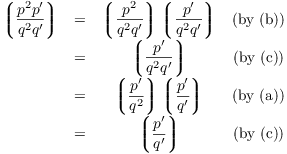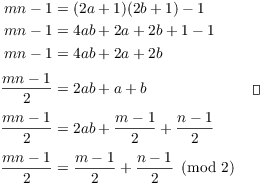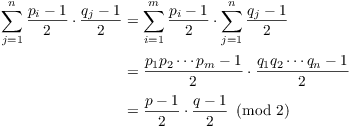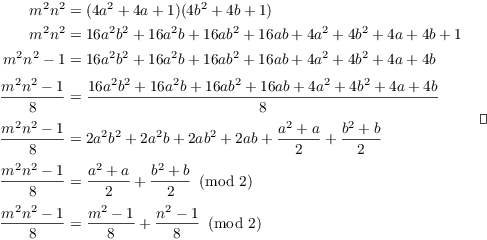It's a little inconvenient that the Legendre symbol ![]() is only defined when the bottom is an odd prime. You
can extend the definition to allow an odd positive number on
the bottom using the Jacobi symbol. Most of the properties of
Legendre symbols go through for Jacobi symbols, which makes Jacobi
symbols very convenient for computation. We'll see, however, that
there is a price to pay for the greater generality: Euler's formula
no longer works, and we lose part of the connection between the value
of a symbol and the solvability of the corresponding quadratic
congruence.
is only defined when the bottom is an odd prime. You
can extend the definition to allow an odd positive number on
the bottom using the Jacobi symbol. Most of the properties of
Legendre symbols go through for Jacobi symbols, which makes Jacobi
symbols very convenient for computation. We'll see, however, that
there is a price to pay for the greater generality: Euler's formula
no longer works, and we lose part of the connection between the value
of a symbol and the solvability of the corresponding quadratic
congruence.
Definition. Let ![]() , where
, where
![]() and q is a product of odd primes:
and q is a product of odd primes:
![]()
(The ![]() need not be distinct.) The Jacobi
symbol
need not be distinct.) The Jacobi
symbol ![]() is defined by
is defined by
![]()
Note that the Jacobi symbol and the Legendre symbol coincide in the
case where q is a single odd prime. That is why the same notation is
used for both. It's clear from the definition that ![]() .
.
Lemma. If q is a product of odd primes and a
is a quadratic residue mod q, then ![]() .
.
Proof. Write ![]() ,
where each
,
where each ![]() is an odd prime. Suppose a is a quadratic
residue mod q. Then
is an odd prime. Suppose a is a quadratic
residue mod q. Then ![]() and
and ![]() has
solutions.
has
solutions.
Since ![]() , it follows that
, it follows that ![]() and
and ![]() for
for ![]() . Hence,
. Hence, ![]() for
for
![]() . Therefore,
. Therefore,
![]()
However, the converse is false: If ![]() is a
Jacobi symbol and
is a
Jacobi symbol and ![]() , it
does not follow that p is a quadratic reside mod q.
, it
does not follow that p is a quadratic reside mod q.
Example. Show that ![]() , but 2 is not a quadratic residue mod 15.
, but 2 is not a quadratic residue mod 15.
Since 2 is not a square mod 3 or mod 5,
![]()
Therefore,
![]()
However, here is a table of squares mod 15:


The table shows that 2 is not a square mod 15. The quadratic residues
mod 15 are 1 and 4, as those are the squares that are relatively
prime to 15.![]()
The results that follow amount to saying that the algebraic properties of Legendre symbols hold for Jacobi symbols --- and indeed, the proofs of these properties typically use those properties for Legendre symbols.
Theorem. Let q and ![]() be odd positive numbers, and suppose
be odd positive numbers, and suppose ![]() . Then:
. Then:
(a) ![]() .
.
(b) ![]() .
.
(c) ![]() .
.
(d) ![]() .
.
(e) If ![]() , then
, then ![]() .
.
Proof. (a) Write q and ![]() as products of odd primes:
as products of odd primes:
![]()
Then
![]()
(b) Write q as a product of odd primes:
![]()
Then
![]()
![]()
(c) Write q as a product of odd primes:
![]()
If ![]() is an odd prime, then
is an odd prime, then ![]() (as a Legendre symbol). Hence,
(as a Legendre symbol). Hence,
![]()
Next, observe that if ![]() is an odd prime, then
is an odd prime, then
![]()
So
![]()
(d)

(e) Write q as a product of odd primes:
![]()
Since ![]() , I have
, I have ![]() for
for ![]() . Consequently,
. Consequently, ![]() (as Lengendre symbols). Therefore,
(as Lengendre symbols). Therefore,
![]()
Example. Show that if ![]() and q is odd and positive, it does not follow that
and q is odd and positive, it does not follow that
![]()
(Thus, the analog of Euler's lemma does not hold for Jacobi symbols.)
Note that
![]()
But
![]()
The next lemma will be used in the proofs of the formulas for ![]() and
and ![]() , as well
as in the proof that Quadratic Reciprocity holds for Jacobi symbols.
, as well
as in the proof that Quadratic Reciprocity holds for Jacobi symbols.
Lemma. If m and n are odd, then
![]()
Proof. Since m and n are odd, I may write
![]()
Then
![]()
On the other hand,

Corollary. If ![]() are
odd, then
are
odd, then
![]()
Proof. Use the previous lemma and
induction.![]()
The way this corollary will be used in the following proof is the
simple observation that if ![]() , then
, then ![]() .
.
Theorem. Let q be an odd positive number. Then
![]()
Proof. Write q as a product of odd primes:
![]()
Then
![]()
The terms on the right are Legendre symbols, for which I know
![]()
Thus,
![]()
Using the preceding corollary,
![]()
Therefore,
![]()
Theorem. (Quadratic Reciprocity) Suppose p and
q are odd positive integers and ![]() . Then
. Then
![]()
Proof. I'll prove the equivalent statement
![]()
(To get from either this statement to the original one or vice versa,
multiply both sides by ![]() and note
that
and note
that ![]() .)
.)
Write p and q as products of odd primes:
![]()
Then
![]()
Here's what the last double product looks like, multiplied out:

By Quadratic Reciprocity for Legendre symbols,
![]()
Taking the product over i and j on both sides, I get
![]()
Taking the product of powers of -1 causes the powers to add. So
![]()
By the preceding corollary,

That is,
![]()
Hence,
![]()
Remark. In computational terms, this version of reciprocity is like the one for Legendre symbols. Thus, suppose p and q are odd and relatively prime. If either p or q equals 1 mod 4, then
![]()
If both p and q equal 3 mod 4, then
![]()
Next, I'll derive a formula for ![]() , where q
is an odd prime. The proof is similar to the proof of the formula for
, where q
is an odd prime. The proof is similar to the proof of the formula for
![]() , except that I have slightly different
preliminary lemmas.
, except that I have slightly different
preliminary lemmas.
Lemma. If m and n are odd, then
![]()
Proof. Since m and n are odd, I may write
![]()
Then
![]()
So
![]()
(Note that ![]() is even because it's the sum of two odd
numbers, so
is even because it's the sum of two odd
numbers, so ![]() is an integer. Likewise,
is an integer. Likewise,
![]() is an integer.)
is an integer.)
Now

Corollary. If ![]() are
odd, then
are
odd, then
![]()
Proof. Use the previous lemma and
induction.![]()
Theorem. Let q be an odd positive number. Then
![]()
Proof. Write q as a product of odd primes:
![]()
Then
![]()
The terms on the right are Legendre symbols, for which I know
![]()
Thus,
![]()
Using the preceding corollary,
![]()
Therefore,
![]()
Example. Compute the Jacobi symbol ![]() .
.
![]()
Example. Compute the Legendre symbol ![]() .
.
Jacobi symbols can often be used to simplify the computation of Legendre symbols.
![]()
![]()
Copyright 2020 by Bruce Ikenaga